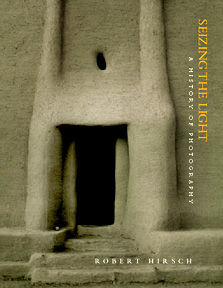|

Seizing the Light:
A History of Photography
Author: Robert Hirsch
McGraw-Hill, 528 pages,
ISBN 0-697-14361-9
McGraw-Hill
http://www.mhhe.com/catalogs/hss/art/
Review by Carole Glauber, copyright 2001
Creating a new history of photography is an intimidating task. Relentless
research, innumerous decisions, attention to countless details, and the
search for distinct photographs from varied sources will challenge even
the most consummate historian.
In Seizing the
Light, A History of Photography, Robert Hirsch takes us on a time-travel
from pre-photography into the digital future. We proceed from John Whipple's
daguerreotype, "The Moon," to Alfred Stieglitz's "Equivalent, 1930," to
Sandy Skoglund's installation/photograph "Revenge of the Goldfish," to
Carol Selter's scanner-made "Ducklings, 1995." His captions often contain
fascinating insights into the work shown. It is a remarkable ensemble
of information and visuals.
Hirsch has fixed his attention on the Western viewpoint, and in doing
so, keeps us focused on the subject and place at hand. He succinctly recreates
William Henry Fox Talbot's experiments and offers cogent explanations
of early photographic processes. Additionally, Hirsch supplements basic
photo history with summaries of the political, social, and technological
contexts that likely influenced the direction of photography. In that
regard, his text is unique for a general photographic history. It is a
technique that requires an additional layer of research and writing and
Hirsch generally handles it well. Sometimes, he veers away from lucidity
with wordy descriptions and opinions. His digression on Stieglitz, Judaism,
Torah, and modernism is a reminder that historians should resist making
assumptions about someone's intentions.
The text transports us on an interesting journey with all kinds of surprising
twists and turns along the way. He introduces us to the physionotrace,
phantasmagoria, eidophusikon, anamorphic drawings, the thaumatrope, amphitype,
and Pistolgraph. He takes delight in highlighting the firsts of photography:
on page 15, Constance Talbot is the first woman photographer, on page
52 she is declared the first woman photo processor; Julia Margaret Cameron
is the first photographer to stress the power and significance of women's
roles; Gertrude Kasebier was the first woman elected to the Linked Ring;
Anna Atkins' book was the first printed and illustrated in cyanotype;
National Geographic was one of the first magazines to regularly reproduce
autochromes; and Cecil Beaton was one of the first to use actresses as
fashion models. The Argandoil lamp was the first modern lighting system;
the megascope was the first solar enlarger designed to be used with a
miniature camera; the first kinetoscope parlor appeared in 1894; the first
true color photograph in 1861; The Ladies Home Journal ran the
first full color reproduction of the carbro process; the Civil War was
the first conflict brought directly into people's homes.
We are entertained with fun facts: by 1894, the Dresden Albumenizing Company
used 60,000 eggs daily for the production of double-albumenized paper;
by 1856, the London Stereoscopic Company, whose motto was "No Home Without
a Stereoscope," had sold an estimated 500,000 stereo viewers and compiled
a stock of 100,000 views.
Hirsch successfully connects his constant forays into cultural history
with photographic history. He offers new perspectives on time-worn topics
with his explanation of the stereo card as a home encyclopedia and symbolic
of Enlightenment education or his comparison of New Topographics to the
Dragnet TV character, Joe Friday who always asked for "just the facts."
He includes a section on the snapshot and describes obscure details such
as tax stamps for card size photographs sent through the mail from 1864
to 1866. The final section of Seizing the Light takes a peak beyond
the digital horizon where he raises the cultural issue of just who gets
to participate in this new technology and who doesn't. Hirsch points out
how "the constant need for new training, equipment, and software upgrades
favors those who already have over those who have not" resulting in older,
young, and poor people getting left behind, potentially creating a technological
underclass. Contrast this situation with the democratization of photography
100 years ago.
The ease of creating photographs has left us saturated with images and
Seizing the Light does not claim to be an exhaustive survey of
photography. While we have the chance to view well-known photographs such
as Weston's famous image of the toilet (Excusado, 1925) and his
Pepper #30, Hirsch has gone out of his way to include many lesser
known photographs rather than relying on the canonical images. One treat
is a delightful self portrait by young Jacques-Henri Lartigue in a bathtub
(My Hydroglider With Propeller, 1904).
Unlike some photographic histories, Hirsch does not ignore women photographers,
but it is a bit lopsided. The last two chapters of the book contain nearly
as many reproductions by women as in the the rest of the book combined.
For example, out of 27 images in Chapter 11, "The New Culture of Light,"
where modernism is introduced, only three are by women. Chapter 14, "Photography
and the Halftone," reproduces 19 photographs with only three by women.
Granted, more women are working as photographers during the last thirty
years, but there are several chapters where no work by women is shown.
His special section supposedly highlighting women pictorialists (he features
only two) is demeaning considering this is one section of early women
photographers where he had the chance to shine. No women landscape, fashion,
or advertising photographers are featured. Each of the 18 chapters opens
with an emphasized image; none are by women. This pattern of exclusion,
even when unintentional, only perpetuates the myth that there were no
women, or none worth mentioning, working in those areas.
That said, Seizing the Light nevertheless offers a considerable
boost to our photographic education. Both students and veteran historians
will find this book useful. Hirsch's willingness to enter previously uncelebrated
territory is to our benefit. He raises the vernacular in photographic
history to prominence and his critical processes provide us with thoughtful
insights to photographers' work.
Carole Glauber is a photographer, photo-historian, lecturer and
author.
Purchase this
book from:
Barnes
& Noble.com
Amazon.com
Art
Catalogues.com
|
